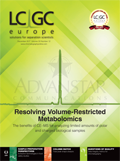42nd International Symposium on Capillary Chromatography and the 15th GC×GC Symposium
The 42nd International Symposium on Capillary Chromatography (ISCC) and 15th GC×GC Symposium will be held at the Palazzo dei Congressi, Riva del Garda, Italy, from 13–18 May 2018.
Photo Credit: Lukasz Szwaj/shutterstock.com

The 42nd International Symposium on Capillary Chromatography (ISCC) and 15th GC×GC Symposium will be held at the Palazzo dei Congressi, Riva del Garda, Italy, from 13–18 May 2018.
The International Symposium on Capillary Chromatography (ISCC) has established its reputation as a leading forum for microcolumn separation techniques. From the first meeting in Hindelang in 1975, the most important developments in capillary gas chromatography (GC), microcolumn liquid chromatography (LC), and electromigration techniques have been presented in this symposium series. The format and the atmosphere of the 42nd meeting will be similar to the previous meetings, however, this year there will be a particular emphasis on mass spectrometry (MS).
The six-day event will feature recent findings from leading academic and industrial experts in the form of lectures and posters revealing the most recent advances in pressure- and electrodriven microcolumn separation techniques, and comprehensive two-dimensional gas chromatography (2D GC). As previously mentioned a particular emphasis will be directed to comprehensive separation technologies that are combined with various forms of MS from unitâmass to high resolution, and from single- to hybrid analyzers. The conference will offer sessions on capillary GC, microcolumn LC, electromigration methods, and microfabricated analytical systems, which are expected to cover lab-on-a-chip, column technology, coupled and multidimensional techniques, comprehensive techniques, hyphenated techniques, sampling and sample preparation, trace analysis, and automation. Application sessions include environmental applications, energy, petrochemical, and industrial applications, biomedical and pharmaceutical applications, and the analysis of natural products, food, flavours, and fragrances.
Workshop seminars from instrument manufacturers and an extensive exhibition of instrumentation, accessories, and supplies will run in parallel to the scientific programme.
At the meeting, the 2018 Marcel Golay Award will be presented in recognition of outstanding contributions in the field of separation science. The Leslie Ettre Award will be presented to a young scientist for research on capillary GC applied to environmental or food analyses. The Giorgio Nota Award will be presented to a scientist in recognition of a lifetime of achievement in capillary LC. The John Phillips Award will be awarded to individuals who have made outstanding contributions to the field of GC×GC analysis. The GC×GC Lifetime Achievement Award honours an experienced GC×GC scientist who has made significant contributions to the field. Scholarships for young researchers will also be promoted by the Interdivisional Group of Separation Science of the Italian Chemical Society (Italy) and its partners.
To encourage scientific exchange and friendship building, the scientific programme will be enhanced with the well-known “Riva Social Programme”, which consists of a welcome reception, cocktail party, classical concert, wine and cheese evening, and farewell cocktails. Considering the interest in comprehensive techniques, the 15th GC×GC Symposium will be organized during the same period to allow scientists to attend both meetings. The 15th GC×GC Symposium will start on 13 May 2018 with a course presented by experts in the field covering the fundamental aspects of comprehensive techniques and a plenary session on 14 May 2018. For both meetings, abstracts for consideration as lecture or poster presentations can be submitted on-line at: http://www.chromaleont.it/iscc
For more information please visit www.chromaleont.it/iscc or e-mail: iscc@chromaleont.it

Regulatory Deadlines and Supply Chain Challenges Take Center Stage in Nitrosamine Discussion
April 10th 2025During an LCGC International peer exchange, Aloka Srinivasan, Mayank Bhanti, and Amber Burch discussed the regulatory deadlines and supply chain challenges that come with nitrosamine analysis.










